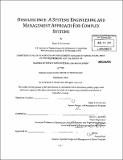| dc.contributor.advisor | Olivier L. de Weck. | en_US |
| dc.contributor.author | Devereaux, Jaime E. (Jaime Erin) | en_US |
| dc.contributor.other | System Design and Management Program. | en_US |
| dc.date.accessioned | 2010-10-12T18:50:14Z | |
| dc.date.available | 2010-10-12T18:50:14Z | |
| dc.date.copyright | 2010 | en_US |
| dc.date.issued | 2010 | en_US |
| dc.identifier.uri | http://hdl.handle.net/1721.1/59233 | |
| dc.description | Thesis (S.M. in System Design and Management)--Massachusetts Institute of Technology, Engineering Systems Division, Technology and Policy Program, 2010. | en_US |
| dc.description | Cataloged from PDF version of thesis. | en_US |
| dc.description | Includes bibliographical references (p. 79-81). | en_US |
| dc.description.abstract | Obsolescence mitigation is an increasingly important aspect of large systems development & maintenance that has often only been considered once obsolescence is imminent. For long lifecycle systems, this has become a major concern as the lifecycles of the components that are encompassed within these systems are often far shorter - up to ten times shorter - than the overall system lifecycle. Many defense systems can be characterized in this manner and therefore require obsolescence mitigation approaches to ensure the continuing ability for the system to perform and evolve. Current system-level obsolescence mitigation practices make recommendations for designing new systems to slow the onset of obsolescence and make the system more flexible when change for obsolescence is required. However, currently fielded systems were often not designed with this in mind. Other obsolescence mitigation techniques focus only on the approach to mitigating component-level obsolescence locally without examining the impact of the change on the system as a whole. This thesis combines the recommended approaches for obsolescence mitigation, the experience and lessons learned for obsolescence mitigation on a real-world case study system gained from interviews with key subject matter experts, along with systems engineering techniques for dealing with engineering change in systems to develop a robust systems engineering and management approach for obsolescence in large complex systems. The thesis provides the reader with a flow chart and a clustered DSM of the tasks along with a checklist that could be used with this obsolescence engineering and management approach. | en_US |
| dc.description.statementofresponsibility | by Jaime E. Devereaux. | en_US |
| dc.format.extent | 99 p. | en_US |
| dc.language.iso | eng | en_US |
| dc.publisher | Massachusetts Institute of Technology | en_US |
| dc.rights | M.I.T. theses are protected by
copyright. They may be viewed from this source for any purpose, but
reproduction or distribution in any format is prohibited without written
permission. See provided URL for inquiries about permission. | en_US |
| dc.rights.uri | http://dspace.mit.edu/handle/1721.1/7582 | en_US |
| dc.subject | Engineering Systems Division. | en_US |
| dc.subject | System Design and Management Program. | en_US |
| dc.title | Obsolescence : a systems engineering and management approach for complex systems | en_US |
| dc.title.alternative | Systems engineering and management approach for complex systems | en_US |
| dc.type | Thesis | en_US |
| dc.description.degree | S.M.in System Design and Management | en_US |
| dc.contributor.department | System Design and Management Program. | en_US |
| dc.contributor.department | Massachusetts Institute of Technology. Engineering Systems Division | |
| dc.identifier.oclc | 666483538 | en_US |
